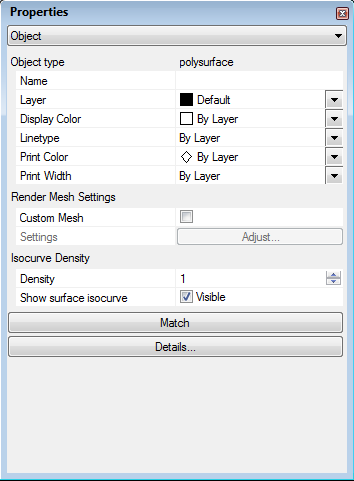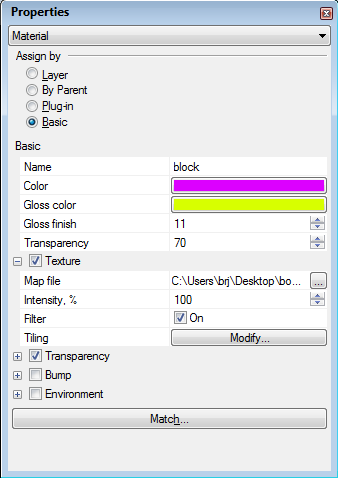TAPESTRY: The Art of Representation and Abstraction
Rhino + V-Ray: Textures
Rhino "Material" Properties
 There are various kinds of texture map (image, bump, transparency, etc.).
Not all circumstances require every kind. You may very well want to combine a plain color with a bump map for an orange-peel, or use only a photo image map of your family as a table-top decoration in a rendering, or you might get ambitious and combine an image with a transparency map to create an 'occupant' for your model. The term "texture map" covers all these combinations, but it's also used for simple image maps (and even for procedural maps). That can get confusing. Recent usage has seen the term Material emerge as the umbrella term for any standard or custom combination of texture options that has a unique name.
There are various kinds of texture map (image, bump, transparency, etc.).
Not all circumstances require every kind. You may very well want to combine a plain color with a bump map for an orange-peel, or use only a photo image map of your family as a table-top decoration in a rendering, or you might get ambitious and combine an image with a transparency map to create an 'occupant' for your model. The term "texture map" covers all these combinations, but it's also used for simple image maps (and even for procedural maps). That can get confusing. Recent usage has seen the term Material emerge as the umbrella term for any standard or custom combination of texture options that has a unique name.
Access to "Material" properties is found in the "Object Properties" panel. The default display in this panel is shown above right. The pop-up list at the very top ("Object" in the above graphic) also makes the "Material" properties available (as shown below).
Assign by
 In the "usual" way, the assign-by options for a piece of geometry include Layer (in which case we should be looking at the Material associated with the occupied layer--but it looks much the same), Parent (meaningless unless this object is part of a block, in which case it references the layer the block is inserted on), Plug-in (for plugins like V-Ray ... more on that later), and Basic (i.e. defined as part of this object and used in Rhino-Render (and maybe in plugins ... more on that later too).
In the "usual" way, the assign-by options for a piece of geometry include Layer (in which case we should be looking at the Material associated with the occupied layer--but it looks much the same), Parent (meaningless unless this object is part of a block, in which case it references the layer the block is inserted on), Plug-in (for plugins like V-Ray ... more on that later), and Basic (i.e. defined as part of this object and used in Rhino-Render (and maybe in plugins ... more on that later too).
Basic
The "Basic" option may consist of nothing more than a custom color, gloss, transparecy value, etc. (see dialog box). However, the fun starts with the "options" represented by the check-boxes at the bottom! (click the [+] signs to expand the simple check-box and see the options.
Texture allows you to select a "map file" (raster image) which will be used to answer the "what color" question during rendering. This might also be called an image map.
Transparency allows you to select an image which will be used to answer the "how transparent is it" question during rendering. The map file should contain a black and white image.
Bump allows you to select a "map file" which will be used to answer the "is it bumpy" question during rendering. Gradients in this gray-scale image define the amount and direction of any bump applied during rendering.
Environment allows you to select a "map file" which will be used to answer the "what's reflected in this surface" question (for reflective surfaces). Not much use for brick or concrete.
Last updated: April, 2014
